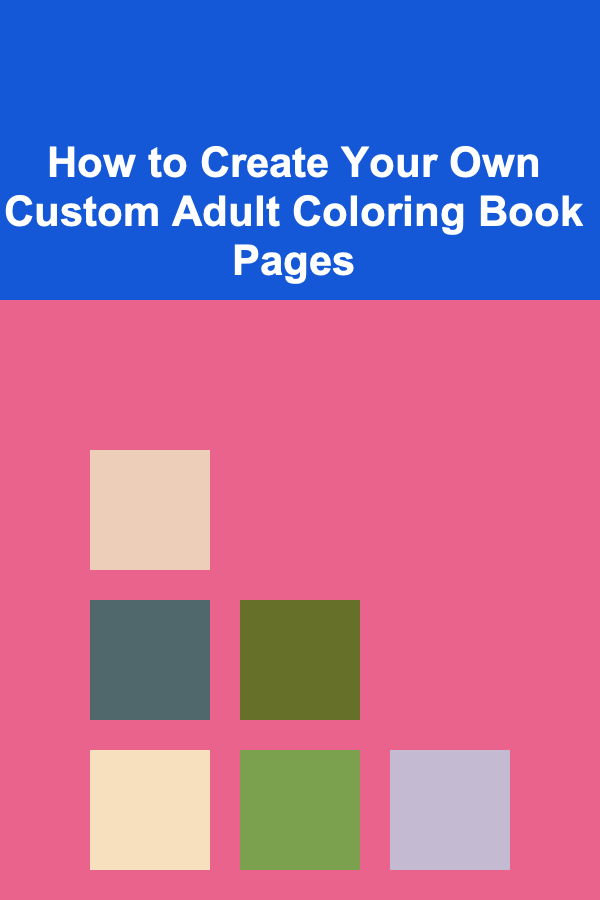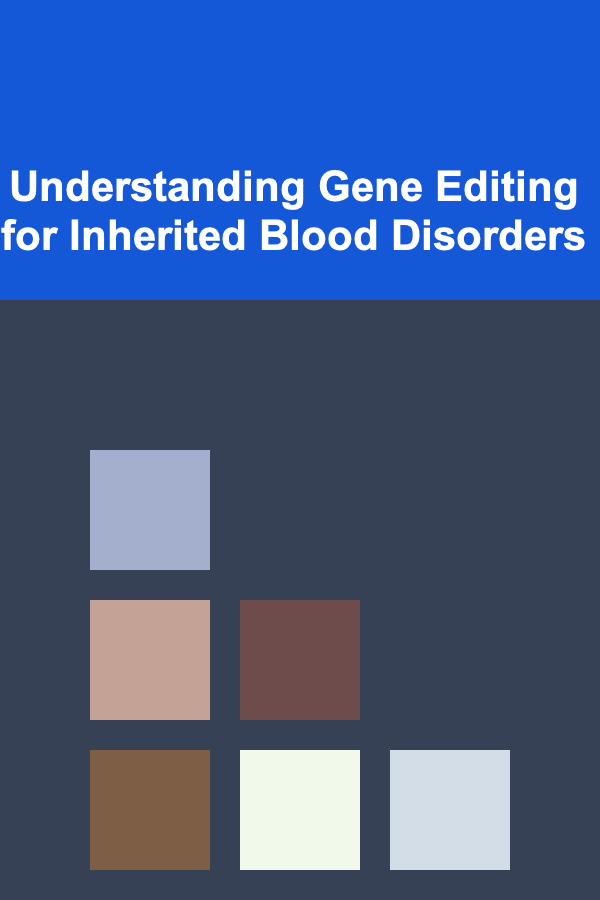
How to Create Your Own Custom Adult Coloring Book Pages
ebook include PDF & Audio bundle (Micro Guide)
$12.99$11.99
Limited Time Offer! Order within the next:

Creating your own custom adult coloring book pages can be an incredibly rewarding and therapeutic endeavor. Adult coloring books have grown immensely popular over the past few years, and for good reason: they provide a creative outlet, a form of relaxation, and even a way to unwind after a busy day. Many adults find joy in coloring intricate designs, and by creating your own pages, you not only personalize the experience but also have the opportunity to craft art that resonates with you personally.
This guide will take you step by step through the process of creating your own custom adult coloring book pages. Whether you're an experienced artist or a beginner, with the right tools, mindset, and tips, you'll be able to design your very own pages that are both captivating and unique.
Understand the Basics of Adult Coloring Books
Before you start creating your own custom coloring book pages, it's helpful to understand what makes adult coloring books unique compared to children's coloring books. Adult coloring books typically feature more intricate, detailed, and sophisticated designs that require patience and precision.
Some popular themes for adult coloring books include:
- Mandala Patterns: Geometric patterns that are often symmetrical and highly detailed.
- Floral Designs: Intricate flowers and plants with complex lines.
- Nature Scenes: Beautiful landscapes, forests, animals, and oceans.
- Abstract Art: Designs that are more freeform and open to personal interpretation.
- Inspirational Quotes: These can be combined with intricate borders and designs.
Understanding these themes and the level of complexity will guide you in creating pages that are suitable for adult colorists.
Gather Your Materials
Creating adult coloring pages requires a few essential tools. Here's a list of materials you'll need:
a. Traditional Drawing Tools
- Pencils: A good set of pencils, including regular and colored pencils, is essential. Graphite pencils are great for sketching, while colored pencils will come in handy for final designs.
- Ink Pens: Fine-tipped black pens (such as micron pens) are ideal for creating bold, sharp lines and adding intricate details.
- Paper: High-quality paper is important. If you plan to sell or distribute your pages, opt for thicker paper that will hold up well to various types of coloring materials.
b. Digital Tools
If you prefer creating your designs digitally, here's what you might need:
- Tablet or Computer: With a drawing program like Adobe Illustrator, Procreate, or even free options like Inkscape or GIMP.
- Drawing Stylus: A stylus will make it easier to draw freehand on a digital platform.
- Scanner (Optional): If you create your designs traditionally, you may want to scan them into your computer for editing and finalizing.
Start with Simple Sketches
If you're new to creating coloring pages, start with simple sketches to practice before diving into more complex designs. Draw basic shapes like circles, squares, or triangles and experiment with layering and combining them to create an interesting visual structure. As you get more comfortable, you can add more complex patterns and details.
a. Start with Basic Shapes
Start your design with a few basic elements like circles, triangles, or rectangles. These will serve as the building blocks of more complex patterns.
b. Incorporate Symmetry
Symmetry is an important feature of many adult coloring pages, especially mandalas. Consider drawing one quadrant of your design and then duplicating it to create a balanced, symmetrical piece.
c. Add Patterns and Details
Once you have your basic shapes, start adding intricate details and patterns to fill in the spaces. You can draw tiny repeating designs like dots, spirals, leaves, or flowers. The more detail you add, the more interesting the design becomes.
Incorporate Different Styles
While traditional mandalas and florals are always popular, don't feel limited by these themes. Adult coloring books often blend various styles of art to create a more dynamic experience for the colorist. Here are a few styles you can explore:
a. Geometric Patterns
Geometric designs can be as simple or as intricate as you like. Use sharp lines and angles to form repeating shapes like triangles, diamonds, and hexagons. This style is often very satisfying for those who love structure.
b. Nature-Inspired Designs
Nature scenes like animals, flowers, trees, and landscapes can be turned into detailed line art for coloring. If you enjoy drawing, try creating a page with various elements from nature, like a bird perched on a branch surrounded by flowers.
c. Abstract Designs
Abstract coloring pages are becoming more popular among adults. You can draw freeform lines, swirls, and shapes that don't necessarily follow any particular theme but still offer an enjoyable coloring experience. Let your creativity flow as you create unique abstract pieces.
d. Fantasy and Whimsical Designs
Consider creating designs that invoke a sense of magic and wonder. Fairies, dragons, castles, and enchanted forests are common subjects of whimsical coloring pages. These designs tend to be more intricate and are great for those who enjoy coloring with a fantasy theme.
Use Contrast and Balance
When creating your coloring book pages, it's important to think about the overall balance and flow of the design. If the entire page is filled with dense, detailed patterns, it may become overwhelming to color. Conversely, leaving too much empty space may make the design feel unfinished.
a. Contrasting Areas
Try to create areas with varying levels of detail. For example, in a floral design, you might have large, simple leaves with smaller, more detailed flowers. This provides a contrast in complexity and offers the colorist different options for coloring.
b. Vary Line Thickness
Use varying line thicknesses to create emphasis and guide the colorist's eye across the page. Thin lines work well for fine details, while thicker lines can help define larger shapes or create focal points in the design.
Refine Your Design
Once you've created a basic sketch, it's time to refine it. Whether you're using traditional tools or digital tools, make sure your lines are clean and sharp. If you're working traditionally, you can go over your pencil sketch with an ink pen or marker to define the outlines. For digital artists, you can use your software's tools to adjust line weight, smooth out curves, and perfect the design.
a. Clean Up Sketches
If you've used pencil for your design, carefully erase any unnecessary pencil marks after inking to keep your page clean. This is particularly important when working with traditional media.
b. Test the Design
Before finalizing, test the design by printing out a page and coloring it. This allows you to see how the design looks in practice and identify any areas that may need further refinement.
Digitize and Finalize
If you've created your coloring page by hand, the next step is to digitize it. Scan your design at a high resolution (at least 300 dpi) to ensure that the lines are sharp and clear.
Once your design is digitized, you can make any necessary edits on your computer. This is the time to clean up any imperfections, adjust the contrast, and ensure that the design is ready for printing.
If you're working digitally from the start, use your program's features to smooth out lines, adjust contrasts, and add finishing touches to your page.
Prepare Your Design for Printing
Once your coloring page is complete, it's time to prepare it for printing. You can print your design on your home printer, or if you're planning to distribute it professionally, you may want to use a print-on-demand service or professional printing service to ensure high-quality prints.
When preparing for printing:
- Ensure your design is saved in the right file format (usually PDF or PNG).
- Adjust the margins and page layout to fit the standard size for coloring books (typically 8.5 x 11 inches).
- If you plan to offer multiple pages, organize them into a PDF document for easy distribution.
Create a Cover Page
If you plan to publish a series of coloring pages, creating an eye-catching cover page can make your coloring book more appealing. A good cover should give a hint of the type of artwork inside and draw the reader's interest.
Distribute Your Pages
Once you've created and finalized your adult coloring book pages, you can decide how you want to share or sell them. There are several options for distribution:
- Self-Publishing: Websites like Amazon's Kindle Direct Publishing (KDP) allow you to publish and sell your coloring books in both digital and print formats.
- Digital Downloads: You can offer your pages as digital downloads on platforms like Etsy, where people can purchase and print the pages at home.
- Print-on-Demand: If you don't want to handle printing and shipping yourself, consider using print-on-demand services.
Conclusion
Creating your own custom adult coloring book pages is a fulfilling creative endeavor that offers a great deal of personal satisfaction. With a little practice and the right tools, you can design intricate, beautiful, and unique pages that others will love to color. Whether you're creating for yourself, your friends, or the world, the process of designing and coloring will undoubtedly provide an outlet for relaxation and creativity. Happy designing!
Reading More From Our Other Websites
- [Home Holiday Decoration 101] How to Plan Stunning Holiday Lighting for Your Home
- [Home Party Planning 101] How to Organize the Ultimate Dinner Party at Home
- [Organization Tip 101] How to Reflect on Your Study Habits for Continuous Improvement
- [Survival Kit 101] The Ultimate Survival Kit for Off‑Grid Homesteaders
- [Whitewater Rafting Tip 101] 5 Reasons Rafting Is the Ultimate Mood-Lifter for Stress Relief
- [Home Holiday Decoration 101] How to Transform Your Space with Home Depot Artificial Christmas Trees
- [Organization Tip 101] How to Set Up a Morning Routine for a Clutter-Free Start
- [Organization Tip 101] How to Use Labels for Organizing Garage Tools
- [Home Storage Solution 101] How to Organize Your Dining Room Storage: Tips for Keeping Your Space Clutter-Free
- [Personal Financial Planning 101] How to Navigate Market Volatility in Your Investment Portfolio

Create Passive Income Streams by Developing AI-Powered Products
Read More
How to Build a Job Interview Checklist for Dealing with Unexpected Questions
Read More
How to Make Money Online as a Speech Therapist: 10 Actionable Ideas
Read More
Understanding Gene Editing for Inherited Blood Disorders
Read More
Designing for Haptic Feedback in VR: A Comprehensive Guide
Read More
10 Tips for Designing a Visually Appealing Music Listening Planner
Read MoreOther Products

Create Passive Income Streams by Developing AI-Powered Products
Read More
How to Build a Job Interview Checklist for Dealing with Unexpected Questions
Read More
How to Make Money Online as a Speech Therapist: 10 Actionable Ideas
Read More
Understanding Gene Editing for Inherited Blood Disorders
Read More
Designing for Haptic Feedback in VR: A Comprehensive Guide
Read More